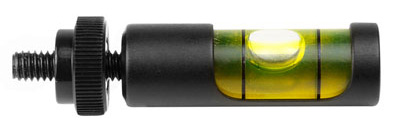
Bubble level. This one is from BKL.
This report covers:
- What cant does
- The answer
- Leveling the scope
- Mounting the scope level
- The whole point
- Summary
Today I’m writing a report for my brother-in-law, Bob. He sent me this text.
“Good morning Tom. I have been looking into improving my accuracy at longer distances and watched a video on adding a bubble level to my scope. Have you done a blog on using or adding a bubble level to the scope to improve accuracy and to actually test a scope with and without a bubble level?”
Well, Bob, let me see. How about the cant test I ran for The Airgun Letter? I reported on that a few years ago and titled the blog report, What cant does. It was published in 2019. Then there was the report titled, Why do you need a scope level? That one was published in October of 2011.
I said this about bubble levels in that report.
“They say that there’s nothing more zealous than a convert, and I expect that is true of me when it comes to scope levels. I have understood their need for a long time and even conducted a fairly extensive cant test back in my Airgun Letter days, but it was my .38-55 Ballard single-shot rifle that really drove the message home. That rifle came with a bubble level in the front sight that is far more precise than the levels we find on air rifles today. The Ballard bubble moves very slowly, making it important to check the level just before you begin the trigger squeeze; because what looks like a level gun one moment can change slowly to a canted gun if you don’t watch the bubble. By contrast, the scope levels I’m using with airguns have bubbles that move very fast, are much easier to see and are far simpler to work with.“
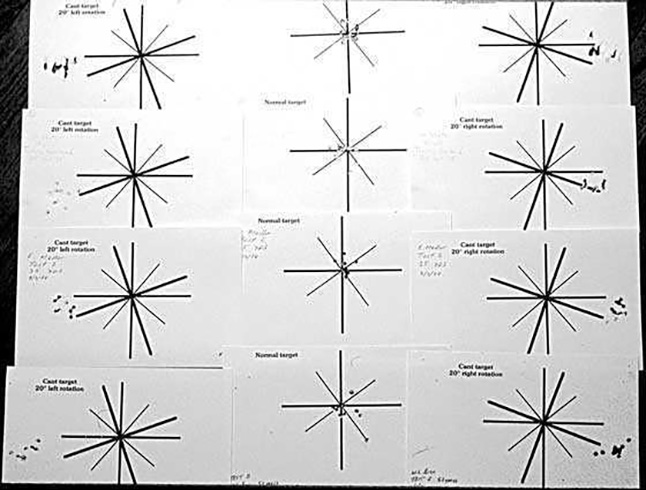
These are the targets from the cant test I ran years ago. The heavy black lines on the target were to help the shooters hold the correct alignment for a canted shot at 50 yards.
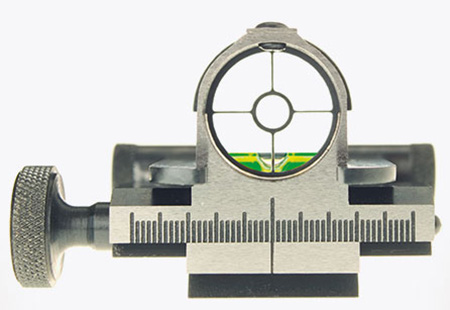
Long range rifles contemporary with my Ballard have bubble levels built into their front sights. They are called spirit levels, but bubble levels is what they are.
What cant does
When I ran the cant test I had the shooters intentionally cant their air rifles 20 degrees and hold them there for 10 shots at 50 yards. Then they canted the rifles in the opposite direction by 20 degrees and shot a second group of ten. For a control they also shot a group of ten with the rifle level.
Nobody will ever intentionally cant a rifle by 20 degrees. It’s too easy to see and avoid. But one degree off can be difficult to see and it can do worse damage than 20 degrees — worse because the shooter doesn’t see it and therefore it opens his group up without his realizing it. It doesn’t appear like a canting problem — just a larger group
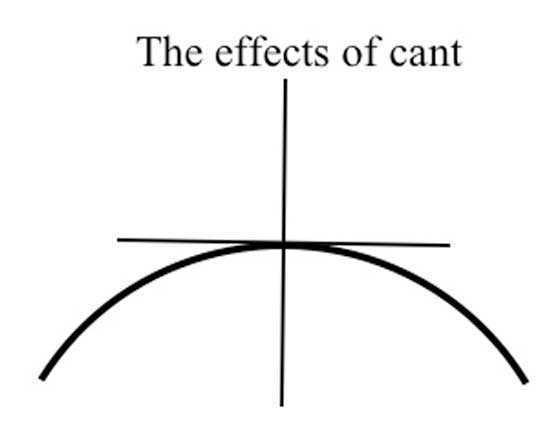
When you cant your rifle the group follows the curved line in the drawing. You see the results of that in the cant test targets above.
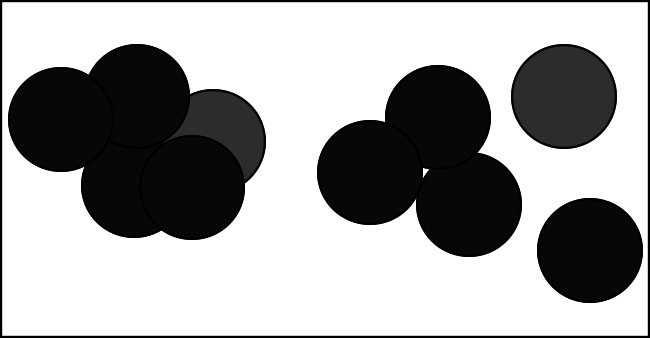
The group on the left was shot from a rifle that wasn’t canted. The group on the right was shot from the same rifle and each shot possibly had cant — or not. Since you can’t tell from the group this one just looks like an inaccurate rifle or pellet.
The answer
Yes, Bob, I have written many reports about canting. And you’re correct about the need to eliminate cant to improve accuracy at longer distances. That’s why I lobbied long and hard for a scope that had a bubble level built in. I saw one in a field target match and ever since I wanted one. The one I saw was a custom job that cost a bundle of money to modify, but the one Leapers fielded several years ago was cheap, in comparison.
Leveling the scope
After you mount the scope, and attach the scope level this question arises — how do you level the scope? The answer is — YOU DON’T! There is simply no way to level a scope because there is nothing (no point of reference) to level it to. Apologies to readers for ending my sentence with a preposition, but Merriam Webster says it’s okay and Sir Winston Churchill is reported to have said, “This is the sort of nonsense up with which I will not put.”
What you do is set the scope in the rings so it looks level to you when you shoulder the rifle. There is nothing on a rifle against which to level, but you can mount the scope so it looks right to you. This is done by turning the scope tube in the loose rings until the vertical reticle line appears to bisect the action or spring tube of your rifle. Then tighten the rings in place.
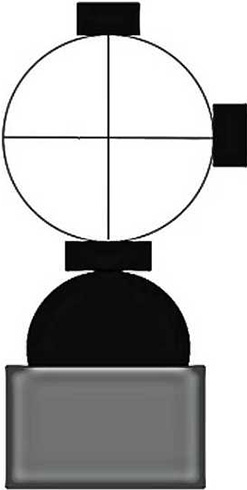
When the vertical scope reticle appears to bisect your rifle’s action or spring tube, the scope will appear to be mounted correctly to you.
Mounting the scope level
Mount the scope level so the bubble is centered when the vertical reticle appears to be straight up and down. Some shooters do this by hanging a plumb bob at some distance (50 yards) and aligning the reticle with it.
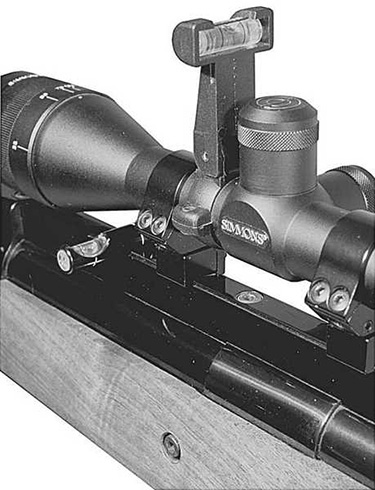
Here, two different kinds of bubble levels are mounted on my Whiscombe rifle.
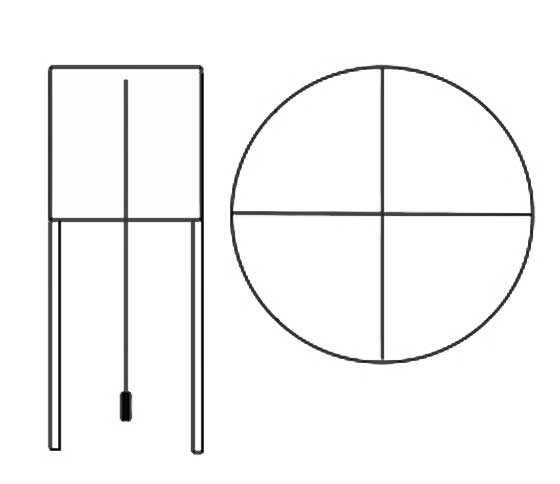
A plumb line has been suspended from a target backer at 50 yards (left). Now, the scope (right) will be superimposed upon it and the vertical reticle will be aligned with the plumb line.
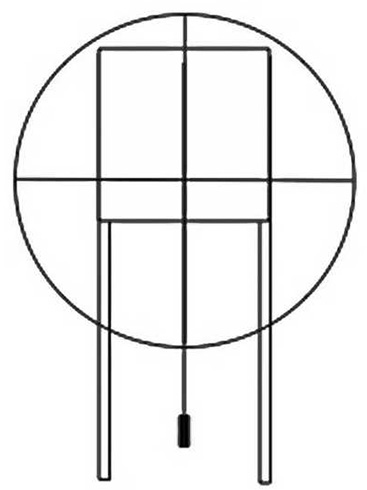
The scope has been shifted over the plumb line and rotated in the rings until the vertical scope reticle is aligned with the plumb line.
And that is it, Bob. If the scope is already mounted on your rifle then skip that step and move to mounting the scope level.
The whole point
The whole point of this procedure is so your rifle will always be in the same orientation, relative to the target. If you always level the bubble, that will happen.
Summary
I hope this report has helped those of you who want to mount bubble levels on your airguns.


B.B.,
Back in my Field Target days, a friend who was not good at scope mounting asked me to mount his scope and level onto his .177 HW97.
I pretty much just did what you’ve outlined in this report…right down to the plumb bob.
Kudos to you for describing the procedure so well that anyone can follow it. 😉
Blessings to you,
dave
Dave,
I sure hope people can follow this. I think it’s confusing for some and clear as crystal for others. I don’t think I have anything to do with that either way.
BB
B.B., to me, the pictures you’ve included help a lot. 😉
Tom,
A spirit level on the front sight? Never see one nowadays probably because everyone uses a scope. Makes a lot of sense as that your will be focusing on the front sight as you aim at your distant target.
Siraniko
PS Section The answer 1st paragraph 5th sentence: “The one I saw was a custome (custom) job that cost a bundle of money to modify, but the one Leapers fielded several years ago was cheap, in comparison.”
Siraniko,
Spirit levels on the front sights are very nice. You can buy them, most especially for peep sight setups, but they are not allowed in most airgun competitions.
You rarely if ever find them inside lower power scopes. The UTG scope is about the lowest power scope I have seen one in. I for one would like to see them in lower powered scopes.
Outside of competitions, most shooters are more concerned with quick shots rather than precise shot placement. That is one reason why glowy thingy sights and dot sights have become so popular. When you are trying to hit something the size of your fist at 500 yards, precise shot placement becomes much more important.
Siraniko,
Fixed it. Thanks,
BB
I’m taking a break.
Today’s pyramydair pop up SPINner was one too many for me, you see, I am too easily offended by this kind of widespread internet detritus. 🙁
So, lucky you(!), I’ve decided to avoid the doorman for a bit, but: I’ll be back ! 🙂
3hi,
Where did that come from? The only such spinner I have seen is on the Airgun Depot site. Well, come to think of it I have seen it on other sites and they are annoying. I just skip them. I have never seen them on PA though.
I see the PA in-your-face spinner all the time, …feel the same way about it as hihihi.
Think that hihih edited the spinner to create his own version shown above.
If you don’t see it when opening the blog then maybe only foreigners have to put up with it.
Hank, I see it, too. 😉
Hihihi, are you going first to the general pyramydair.com site before linking to the blog, or are you going directly to the blog web page? I have not seen the spinner about which you are complaining. Try bookmarking this: /blog/
Do you have to log in each time or do you click the “remember me” option?
I guess I am guilty of just leaving the window open, so I rarely log out of the blog.
Likewise I never see the spinner. As you say, using a link that takes you directly to the blog seems to bypass the promotional material on the main site.
BB,
I do all of those things when I mount a scope. I also have the UTG Bubble Leveler scope to which you refer to. Having the level inside of the scope is nice.
Mounting one on the outside of the scope can be difficult to see. The farther it is from the scope, either above or to the side, the easier it is to see. Also, as far forward as possible helps (focal? distance). The farther from the eye, the better. What you have on your Whiscombe is quite usable for exterior mounting.
You may wish to avoid the bubble levels that clamp to the scope body and are real close to the body. They tend to be very difficult to even see. The usually enlarged ocular lens section or the turret section tend to obscure them.
When I read the pages and pages of convoluted ways people ‘level’ scopes on the forums I always smile. It really is as simple as BB has described. Some people seem to like making things overly complicated!
Ade C,
I have been mounting scopes for over 50 years. I too wonder why some people make it so difficult. It must be the Brother-In-Law Effect. You know, someone’s brother-in-law sells some outrageously expensive scope leveling rig or they get a kick back.
Wow! Looky what I just found!
/product/utg-op3-1-5-6×36-ao-swat-crossbow-scope-ez-tap-ill-bdc-reticle-30mm?a=9406
I know it is for crosbows, but it is usable on airguns, even if the reticle is a little busy. I just may have to get me one.
BB, you may need to talk to UTG and let them know we want, need, desire bubble levels in lower powered scopes.
RR,
I wasn’t aware of such a scope. I might have to test one for us.
BB
RidgeRunner, that’s a pretty interesting scope! I hope B.B. does test one for us. 😉
Please remind UTG we would like a high magnification version again.
The 4-16×56 bubble level is no longer sold.
But definitely need more than 6 power.
Ian
Ian,
If you really want one, I have one. I would trade it for one of these other scopes.
burke 93 at tds dot net
Dave,
I hope so also. I may have to try one myself anyway. If I do, I will let you know what I think.
That’d be cool. 🙂
This question has to do with scopes but also the question of balancing the scope to the rifle (for function, not cost).
I think I am going to keep my Diana 350 Magnum as a longer range pester. It came with a Hawke Airmax 3 – 12 x 44 scope. It sits on a UTG dovetail to Weaver dropper base with high rings and there is a generous bit of daylight between the objective bell and the spring tube. I have a couple of thicknesses of bubble wrap secured around the buttstock as a temporary cheek pad because the scope sits so high. I also now have a TX200 Mark III that came with a Hawke 2 – 7 x 40 scope. Those rings are at the perfect height. I’m thinking of switching the scopes, even though that may be a daunting task to find the right base and ring combination. Any suggestions?
Here’s a couple of pics for comparison:
Roamin Greco,
I’d be tempted to take off the dropper base and just use shims under the rear scope mount.
(I guess you’d still need a new set of rings, though)
It looks like the bell housing would be right down near the receiver without that dropper base.
I’ve never used a dropper base, but I have shimmed a lot of scopes. 😉
Blessings to you,
dave
Thanks, Dave. Part of the reason for the drooper base is the giant lug that hangs over the front of the dovetail scope mounting rail on the Diana rifles to keep everything from sliding back with recoil. There are no proper scope stop pin holes in a Diana scope rail. If I went with rings only, I think I would have problems.
And the TX:
RG
The stock of the TX looks gorgeous! Still the 350 is a very nice looking, and especially feeling, rifle. Please just get her a lower based system.
Thanks Bill. And Χριστός Ανέστη!
I really lucked out on this one. It was up for auction and described as having a “missing bolt.” I thought that was unusual but I priced out the part and with the scope it still made sense to buy, especially since this one is on the bucket list (gotta buy one before I “kick the bucket”). (Thank you also o Great Enabler, B.B.!) I figured, even if I don’t keep it, I could easily get my money back. This is the walnut stock version. Once I got it, I realized it was not missing the bolt at all. It was just loaded with so much grease and the trigger was totally misadjusted. Happily, (since I don’t have a spring compressor yet) I could disassemble her and clean her up. She works just great and what a bargain! But I can’t help but think she could really benefit from the higher power scope for field target, and then I could use the lower power scope for pesting and hunting with the 350 out to 50 yards, which is the limit of my property.
Roamin
If it was me the scopes would get swapped just out of curiosity. But I’m an incurable optics switcher and just enjoy the mounting and sighting in.
Deck
BB,
This is a theory question not a practical question, but I don’t understand this part.
“After you mount the scope, and attach the scope level this question arises — how do you level the scope? The answer is — YOU DON’T! There is simply no way to level a scope because there is nothing (no point of reference) to level it to.”
In theory, wouldn’t I want to set it up so that the crosshairs, when vertical say to the plumb line you described, be in line with the bore? Wouldn’t that be what I am trying to ‘level’?
Let me exaggerate to make my point. Let’s say I have a rifle set up with a 56mm objective scope, and a shroud over the barrel, giving us a bore to centerline distance of 2″. So I ‘level’ the scope as indicated above, and it looks level to me, but (remember we are exaggerating) the rifle sits at a 10 degree angle so the bore is not only below, but also to the right (looking through the scope) of the scope centerline compared to vertical, at least as far as gravity is concerned. I then sight in for 50 yards, and let’s just say in this example that at any other range the pellet is below the crosshairs. I would then also have to contend with the point of impact being to the right at less than 50 yards and to the left beyond 50 yards, right?
I know that wouldn’t make any difference to anyone but serious competitors, but is the theory right? Even if it is, actually getting it done would be another story, but I just want to make sure I understand.
CB
CB,
Not only does it not matter to anyone but serious competitors — it also doesn’t matter to them. Not even world champions. Their only concern is where the pellet goes when they shoot.
I didn’t want to put this into my report, but your question makes me want to tell everyone now.
I used to be a mortar platoon leader. I had four 4.2-inch (106mm) mortars that are approximately as powerful as 105mm howitzers, through they can’t launch their shells as far.
Their tubes pointed up at the sky, yet their sights were aimed straight ahead — at posts stuck in the ground 40-50 feet in front of the gun. I don’t think it is possible for optical sights and rifled barrels to get any farther out of alignment with each other than the sights and tubes of those mortars. What we did was correlate where the shells were striking and we had a complex way (please don’t ask me to explain or we won’t have a blog tomorrow) of correlating where the tubes were sighted, in relation to where their shells were falling.
What I’m saying is — forget where you think the barrel is pointing. Be concerned with where the pellet is hitting.
I know this sounds like either the operation instructions for a microwave or Mr. Miyagi’s advice on how to defend yourself, but it’s the best I can do.
BB
BB,
I do understand that, in my example, at 50 yards it would make no difference at all. Perhaps I didn’t state it clearly, but my question was more that it would, or might, make a difference at say 25 or 75 yards. But it also might be that I am just dense this morning and am missing something obvious. Thanks for the response anyway.
CB
BB,
I’m actually with Captain Bravo on this one . . .
While the likely deviation in most cases is small (because the misalignment is small), in the example he gave the misalignment it would be significant, and thus cant error at varying distances would be significant.
Your explanation of the mortar example is interesting, but it is the correlation step that is critical – all we have with the optical scopes is straight optics, so the error would not be corrected.
When setting up a scope on a gun that I feel will be “permanently” on it, I do go the extra step and mount it using the “mirror method” and it never fails – at most it might be work that is not needed, but it will never induce an new and unique error. For those that don’t know it, you set up with the gun a good five yards or so (depending on parallax setting of the scope) away from a mirror set up to be perpendicular to the gun on a rest. Then you point the gun so the barrel is as perpendicular to the mirror as you can get it, ensuring there is no up and down or side to side tilt, and then rotate the scope so the reticle bisects the barrel when you look for it – note that the barrel does not have to be straight up and down for this, just perpendicular to the mirror. This action puts the scope and muzzle in the same plane so they move as a unit (assuming the bore is straight down the barrel, which it never is perfectly). That lets the bubble level do its job of leveling the system and eliminating cant error at varying distances as best as possible.
Alan
Alan,
That mirror technique seems like it would be a good answer to the idea of getting them vertically aligned.
CB
BB: I do “level” my scopes to my springer scope rails and make an assumption (we know what “assumption” means), that the scope rail is in good alignment with the bore axis. I also make another assumption that the hinge/breach block on the break barrel is aligned with the bore axis.
I do a kind of motar sighting adjustment using the door frame of my ballistic closet as my known vertical at approximately 10 meters. That door frame was purposefully and carefully plumbed in construction of the balistic closet.
I use either my clamp on the scope rail or a torpedo level on the barrel breach block to get the rifle in a vertical plane. The assumption here is that the top of the scope rail or breach block is perpendicular to the vertical plane of the bore.
Holding the long gun in the rifle stand and continually checking the level choice, I align the scope in the rings so that the vertical reticle is laid on the door frame. That minimizes, in my estimation the cant caused by the relative alignment of the scope to the rifle itself. It DOES NOT eliminate any cant that I put into it while shooting if I don’t either check the clamp on level or check the hold against the door frame to the ballistic closet.
I am sure that this would not pass muster in serious competitive shooting but it works for my 10 meter basement range and the limits of my property lines for removing garden and decorative plantings pests that like to dine on them.
I keep the clamp on spirit level on my Hatsan 135 in .25 caliber when not in use for setting up new additions to the arms locker. I do this because of the weight of that piece and the violence of the shot cycle. I have to keep my eye on it not unlike my Diana 350 carbine that has destroyed two scopes and shakes everything lose.
Of course, I am making some BIG assumptions about the machining process of the manufacturer and the engineered parameters and relationships in my rifles. So far, when I do this routine, my pieces seem very accurate and stay that way. Doing this before I begin zeroing in the scope also seems to lessen the problem of “scope chasing”
So, turning “IMHO” to: ON
(now that I have that out of the way 😉 )….
“Leveling” (I call it “plumbing)” the scope and using bubble levels is not necessary for the people who use smaller (less than 44 mm objective lenses) scopes mounted close to the bore and plink at less than 25 yards.
The people who are into precision target shooting or Field Target competition typically use large scopes (50, 56 mm or greater objective lenses) which need to be mounted higher off the bore will see a big difference in score if the scope and bubble level is not properly setup.
When bench shooting at fixed distances (e.g. 50, 100 yards) scope setup errors can be zeroed out and if you don’t cant the rifle (or cant it exactly the same way) all will be OK. Shooting at varying distances benefits from a proper setup.
I use 50 and 56 mm scopes on my long range airguns and with the scope being mounted so high over the bore I can definitely see the affects of canting the rifle at my usual 40 yard testing range. I feel that a bubble level is mandatory for this kind of setup and shooting at longer ranges.
I include horizontal and vertical reference lines on my targets and I make a point of being sure that they are mounted level (to gravity) on the backstop. I also setup my airguns such that the scope/bore is plumb (to gravity) and the cross hairs are level, so that when the bubble on the rifle is centered I know that the trajectory of the projectile will be in the same plane as the force (gravity) acting on it. If the projectile is out of plane it’s “skidding” (sliding sideways) on the way down range. The last thing I do before breaking the shot is to check the bubble level is centered, a sudden shift in my POI tells me very quickly if I forgot to.
Using the bubble on my long range airguns make a huge difference to my groups, I have several PCPs that will routinely print sub 1/4″ groups at 40 yards. Before having bubble levels it was 1/2″ to 5/8″ groups. Cant will affect the results, going from half-MOA to one-MOA is a significant change when shooting beyond 30 yards.
If the scope is plumb and leveled (to gravity) and the cross hairs look off, I work on correcting my hold or modify the stock to fix the problem. Adjusting the cross hairs to look level when the rifle is cockeyed is not going to help long range accuracy.
“IMHO” now turned: OFF …soap box is free 🙂
I have my moods – sometimes I’m anal about precision, most of the time I’m a casual plinker.
Just my 2 cents.
Hank
Hank, that was worth way more than 2 cents.
Thank you, and thanks, B.B. for another great thiugh-provokimg blog.
Thought-provoking…don’t know what happened up there.
A friend of mine has been making these, electronic levels that also receive and display the signals from your Fx chronograph.
Or it can be used as a stand alone level.
It can an attach to your scope rail, or the scope tube.
The main downside?
Rechargeable batteries.
Ian.
https://m.youtube.com/watch?v=EYmoshu_wZA&feature=youtu.be
Anyone know where I could source a replacement stock for a Diana Model 16?
I may be missing the point here and am a little confused.
I thought that bubble levels were intended to keep the rifle level when you shoot, and the scope is mounted level ‘to the rifle’ when you install it.
I simply check the level of the weaver mount and compare it to the level of the top turret on the scope using combination squares. Dovetail? level it to the bottom half of the scope ring installed, measured and held level prior to installing the scope. Then check everything against level objects.
Found out the bubble level inside the early 56 UTG’s was not always installed level ‘within’ the scope. Mine was actually almost a half bubble offset when everything was checked against a level picture frame on the wall. It was up against one of the centering marks on the glass.
Am I missing something? It doesn’t seem that complicated, but then again, most people don’t have combination squares, I guess.
One thing I know for sure is that many low cost bubble levels are not true. Turn it around and the bubble is in another place when looked at. I compare them to known good ones and place an X on the side that has a true reading.
Bob,
From extensive checking of different airguns, rifles, scopes and scope mounts I’ve come to the conclusion that you cannot count on anything (let alone everything) to be machined or assembled square or parallel to the other parts. Some might be close, but tolerances say they probably won’t be.
Think of the tolerances in all the bits…
Bore to barrel
Barrel to receiver
Machining of the scope mount
Machining of the scope bases
Installation of the scope bases
Machining of the scope tube
Machining of the turret components
Machining of the erector tube
The scope assembly
Yeah, and I probably missed a few.
Balancing an accurate(?) bubble level on the receiver or scope turret won’t necessarily be perpendicular to gravity.
I see it as being simple. Trajectory is (mostly) influenced by gravity so that’s the reference.
I align the center of the bore to be directly below the center of the scope using a plumb bob as reference; the rifle is now in plane with gravity. Without moving the rifle out of plumb, I align the vertical cross hair to be in plane with gravity using a plumb bob. Then I add a scope mounted bubble level adjusted to the agree with the rifle and cross hairs.
So now the sighting system is in plane with gravity and the trajectory and the bubble level is the reference that I’m holding the rifle correctly.
Then all I have to do (ignoring wind, spin-drift, earth’s rotation etc.) is to align the bubble, hold over correctly and break the shot cleanly to hit my target… that’s the theory anyways 😉
For what it’s worth Bob.
Cheers!
Vana2
Yes, I pretty much ignored all those slight problems and rely on adjusting the reticles to compensate for POI. Like I mentioned before I’m not big on target shooting after I set up a scope and especially long range. You guys are far too deep into it for me, but thanks for clearing things up.
I will probably just confuse the issue, but here goes.
Say you have a perfect gun and projectiles that always shoot in a vertical plane. You sight in at 50 yards and at 100 hundred yards you are of to the side 1/4 inch with your scope perfectly level. That would mean your scope and barrel are off the vertical line 1/4 inch at the end of the barrel. That is more than you should ever get if you are careful in mounting the scope. Well unless something on the gun is way off but that should be visible.
Cant is the more critical issue look at B.B.’s cant test at 50 yards. It doesn’t take much cant to move the scope out of alignment with the barrel.
Don
B.B. and Readership,
I looked in on the Blog last night right after it posted and after reading Tom’s excellent work on answering brother-in-law Bob’s text message: “Good morning Tom. I have been looking into improving my accuracy at longer distances and watched a video on adding a bubble level to my scope. Have you done a blog on using or adding a bubble level to the scope to improve accuracy and to actually test a scope with and without a bubble level?” I chuckled and shut off my tablet after thinking about all the previous valiant attempts of the Godfather of Airguns® to clear up this minor matter for Airgunners.
SAY WHAT! minor matter of CANT! … AND scope leveling too! What pray tell is wrong with shootski!
NO! I have NOT been drinking, taking pills, injecting, sniffing, snorting, eating mushrooms, and i also don’t smoke ANYTHING!
IF you (b-i-l too!) all are SO concerned about having FUN shooting STOP watching all those videos; most are of no value to your having FUN shooting airguns at any distance. Just do your best to follow what B.B. has written over the years and make certain to pay particular attention to the rare occasions when he corrects himself.
IF you do competitions then you should have a qualified Coach, Instructor, or Mentor and you need to trust them especially if you are paying them for their knowledge and experience.
If you look into what B.B. writes it is not about Plane Geometry, as sight systems and optics surely are. He writes of Ballistics which happens in 3D; unless you want to add TIME then it becomes four dimensional.
One last part to this harangue: there are many variables in the world of projectile launching in the great outdoors; the WIND however still stands supreme.
Get the BASICS down and then…
Learn to read the WIND if you want a variable to try to tame…all else is a fools errand.
shootski
shootski,
Thank you!
I’ll try to get your check in tomorrow’s mail. 😉
BB
Shootski gets PAID????
…Harrrummphhh, mutter, mutter 😉
Vana2,
I have a bridge designed and built by a guy name of John A. Roebling over the East River I can let go to you for cheap once B.B. pays me my Fanboy Fee.
I hope that will assuage your distempered muttering!
shootski
Hey, if anyone gets paid for the Roebling Bridge, it should be me. I am from suburban Cincinnati and that’s where the mother of the Brooklyn Bridge lives. Age before youth and inexperience….
LFranke,
Lol! Trenton Makes the World Takes!
shootski
Vana2,
Until that happens you might gnaw on this: https://www.jbmballistics.com/ballistics/calculators/calculators.shtml
Site will help with your endeavors to shoot farther…
shootski
Shootski,
Maybe it is just me, but I find the discussion of the theory fun too. It isn’t as much fun as shooting, but isn’t that part of the reason we are all here?
On a side note, I think one thing I might be missing is that if you only shoot, and sight in, at one distance, cant of almost any amount wouldn’t matter as long as it was consistent.
CB
NCaptain Bravo,
“… but isn’t that part of the reason we are all here?”
YES! My point exactly and not watching those videos. Most of them are not going to increase YOUR FUN and much of it is full of incorrect and flawed information or to sell you something you really don’t need.
On your side note there is sighting in at a fixed distance and i think you realize Cant (TILT to 90° to either side) does not matter one bit at the sighted in distance for POI as long as the degrees of Cant are identical for each shot. In at least one of Tom’s past discussions on Cant he had a drawing showing the curved path that happens with amount of Tilt and how it varies.
So for different distance shooting if you could guarantee identical Tilt angle you could put together a D.O.P.E. Table/Formula (or computer program) that would predict POI (Point Of Impact) for every distance. That isn’t called sighting in however that is D.O.P.E. (Data On Previous Engagement) and speciffically this type of data: https://www.jbmballistics.com/cgi-bin/jbmtraj-5.1.cgi
Look for the CANT entry and in general it gives a good visual cue on just how MANY variables there are that are known.
Once you know how all of them effect a single shot we have a profession you might be interested in.
This is NOT PLINKING.
shootski
B.B.,
Promises, promises!
Denada.
shootski
So … Has anybody ever considered having a friend move the target so the pellet always hits dead center instead of fiddling with the scope?
Wait, that won’t work. because every shot will still land where the previous one did after you aim at the same spot?
OK, I got it! Move the target … after you aim at where it used to be.
Sometimes I scare myself solving problems so simply 🙂 Carry on.